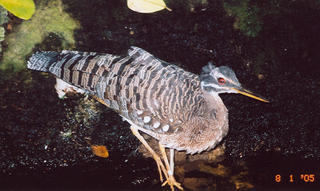True Believers, Skeptics, & Hoodoo Birds
Michelle and I recently attended a local Audubon Society meeting where the main topic of discussion was the Ivory-billed Woodpecker in Southeast Texas. As you may have gathered by now I'm slightly obsessed with this subject.
Apparently I'm not alone in this regard. The IBW has become the holy grail of birding. There are good reasons why it should be the focus of so much attention. First of all, it's extremely rare. It's very existence has been an intriguing mystery, and for many years it was presumed by experts to be extinct. Secondly, this isn’t just some little tweety bird. It's BIG, with a chisel-like bill that can rip trees apart. As big and impressive as a Pileated Woodpecker is, this bird is even more so. It's large size and elegant plumage would awe even a non-birder (one of its colloquial names, the Lord God Bird, is no doubt a reference to the sort of exclamation its appearance was apt to elicit). Then there's the fascinating history of its long slide toward extinction, its disappearance, rediscovery, and re-rediscovery.
Imagine a magnificent black and white bird that only inhabits the deepest most impenetrable swamps. A bird so rare that its very existence is questionable. Ornithological literature offers clues as to where to look and what evidence to watch for, but the search area is vast, and the bird is shy and elusive. As James Tanner wrote, it’s like "looking for an animated needle in a haystack.” There are birders who would trade every species on their life lists for one glimpse of a living Ivory-bill, and the quest to find it has become tantamount to a treasure hunt.
Chester Moore was the main speaker at the meeting we attended. He writes an outdoor column for two local papers, the Port Arthur News and Orange Leader. He also maintains a cryptozoology web site, and in his spare time searches for IBWs (as well as jaguarundis, giant catfish, and bigfoot – yes, bigfoot). As a journalist he was involved in the 2002 Zeiss Sports Optics search of the Pearl River Bottoms in Louisiana (incidentally, the eye of Hurricane Katrina passed right through that area, and the storm undoubtedly did some heavy damage to the forest there).
Chester is a “true believer” where IBWs are concerned. He unequivocally told us that there ARE still IBWs in S.E. Texas, and claimed that he had found evidences of their presence, and even had a possible encounter with one, while searching along the Sabine River. His enthusiasm is infectious. Unfortunately the proof is lacking.
I may be obsessed, perhaps even fanatical every now and then, but I’m no true believer. I think it’s very unlikely that there are any IBWs left in Texas. But there’s still the remotest chance that a few have survived, and it’s that slim hope that motivates me to continue searching the Big Thicket. At least the habitat is interesting, and there’s plenty of other wildlife to observe while I’m chasing feathered ghosts.
Generally I’m unimpressed with physical evidence purported to show the presence of IBWs. I figure it’s wise to apply Occam’s razor to these situations. When you hear hoofbeats, think horses, not zebras (assuming you aren’t on an African savanna). A large irregularly shaped hole in a tree could have been made by an IBW, but there are more plausible explanations - like excavation by over-achieving Pileated Woodpeckers, or enlargement of an existing cavity by bored squirrels. Likewise the bark stripping that is so often reported as evidence of IBWs at work. Pileated Woodpeckers will also rip the bark off trees, and bark naturally sloughs off snags. I want better evidence for extraordinary claims.
In Arkansas they have such evidence. The video may be inconclusive, but there are numerous sightings by competent observers (the most compelling proof, in my opinion). Autonomous recording units (ARUs) deployed in the Arkansas swamps have recorded what sound like kent calls and double raps. One of the ARUs also picked up a conversation between a couple of boaters who had noticed the recording device. One of them can be heard saying “they’re looking for some kind of a bird, a hoodoo bird - the Ivory-billed Woodpecker’s what they’re looking for.”
Hoodoo bird – I like that. He may have been right.
Lately I’ve been reading a couple of books: James Tanner’s classic “The Ivory-billed Woodpecker,” and “In Search of the Ivory-billed Woodpecker” by Jerome Jackson. Both men traveled throughout the southeastern U.S. in search of the IBW. Tanner observed the Singer Tract birds; Jackson had only fleeting tentative encounters with IBWs in Cuba and maybe - just maybe - in Mississippi. Their books offer little hope for the bird’s continued survival. The facts are depressing. IBWs required extensive tracts of virgin forest – forest that for the most part no longer exists. Both Tanner and Jackson emphasize the scarcity of suitable habitat. By the 1930s most of the ancient bottomland forests of the south had already been logged. To Tanner, who had searched throughout the south, the Singer Tract was truly unique, the last pristine wilderness of its kind. And the Singer Tract was cleared within a decade.
Neither Jackson nor Tanner were very impressed with the Big Thicket as potential IBW habitat. Tanner dismissed it as “thoroughly logged over, and greatly over-rated as a wilderness area.” This is sadly true. The Big Thicket is almost entirely cutover and secondary growth. No arguement there. But my concern is that Tanner may have used his limited experience with a single small population of IBWs in the Singer Tract as the definitive guide to what is (and is not) appropriate IBW habitat. It’s possible that Tanner may have underestimated the IBWs adaptability and overestimated it’s dependence on one forest type - or so I hope. Certainly the Cuban IBWs inhabited an environment that was very different from that of the Singer Tract.
It is encouraging to note that it has been many years since Tanner first visited the Big Thicket, and that in the intervening years the forest has matured and gained some protection through the establishment of the Big Thicket National Preserve.
If there are any IBWs in Southeast Texas – a doubtful proposition – they would probably occupy much larger territories and roam over a considerably wider area than the birds that Tanner studied in the Singer Tract. His research indicated that each pair required several square miles of optimal habitat. Large expanses of virgin bottomland forest are as rare as IBWs these days, and in an area like the Big Thicket birds would have to wander over a much larger area to find the same food resources. This is probably true of the bird(s) in Arkansas as well. Consider the vastness of the forests it inhabits, the large size of its home range, the difficulty of access, and the extreme wariness of the bird, and it’s not surprising that the few remaining IBWs would be hard to find.
Jerome Jackson has been among the most skeptical of the rediscovery in Arkansas. Interestingly, in his book he ranks the southern states according to his assessment of how likely they are to still have IBWs. Arkansas takes last place on his list. Texas ranks a bit higher in probability. To Chester Moore and other Texas Ivory-bill hunters that has to offer some encouragement. After all, if an IBW could survive in the remnant forests of eastern Arkansas, why not here?






